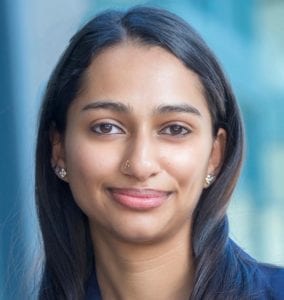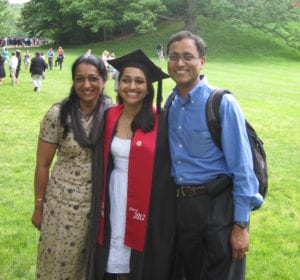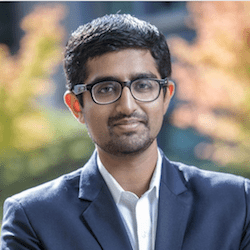As commencement approaches, we’re interviewing grads-to-be from different Haas programs about their experiences at Haas and future plans. We kick off our “five questions” feature with Gauri Subramani, PhD 21, one of 11 Berkeley Haas PhD students participating in virtual commencement May 1.

Gauri Subramani studies the intersection between innovation and representation, specifically with respect to gender. She’s studied patents as a way to measure innovation in her research, examining the reasons for the underrepresentation of women in patents in the U.S.
This fall, Subramani will join the faculty at Lehigh University in Bethlehem, Pa. The first course she’ll teach to undergraduates is Leadership in Organizations. (Watch a video about her research here)
Here’s our interview:
You majored in economics and English as an undergrad at Wellesley College and ended up working in the Office of Economic Policy in Obama’s Treasury Department after graduating.
Did the English major help?

Economics got me in the door, but English helped me to write and to be a good communicator. I really benefited from doing both. This was my second job out of college, which I held for two years, and they were excited that I had a background in English. A lot of work goes into writing clearly about economic insights and the role of the Economic Policy team at the Treasury Department is to translate policy on behalf of the Treasury Secretary, President, and others in the administration. If you can’t communicate with others, you are working in a void.
You must have brought those same skills to your PhD research?
Yes, definitely. I feel that being able to write in an accessible way is really important, particularly as an academic. I’ve also learned from the work of researchers whom I respect a great deal. For example, (Harvard professor) Raj Chetty is an amazing economist and has written very readable papers exploring the drivers of inequality. Partly because of its accessibility, his work also gets a lot of attention in the policy world and in popular press. My favorite paper that he’s written is about who becomes an inventor in America (which explores the roles of family background and exposure to innovation by examining data available in tax records). It inspired the work that I’ve done.
You’ve researched how women and men differ when it comes to applying for patents. Why are so many more men granted patents over time?
To begin, women are less likely than men to apply for patents; roughly 86% of applications come from men or all-male teams. But even conditional on applying for a patent, women are less likely to end up receiving one than men. My coauthors and I studied this gap and found that female patent applicants are less likely to continue in the patent process after receiving a rejection, which is a fairly common event, and inventors can respond to these rejections and their application will continue to be evaluated.
To begin, women are less likely than men to apply for patents; roughly 86% of applications come from men or all-male teams. But even conditional on applying for a patent, women are less likely to end up receiving one than men.
We did find evidence that the gender gap is reduced for applications when an attorney is used or the patent applicant is affiliated with a firm. There are so many environmental factors that can contribute to gender disparities, including the type of support women get at firms, and how organizations invest in a male versus a female inventor. Our findings suggest that access to resources and information can help decrease the gender gap in patenting.
How did you decide to study patents? Was that your idea when you started the program?
I am broadly interested in understanding representation in innovation, and a project I spent some time on was exploring the underrepresentation of women in clinical trials and the impact that has on health outcomes. This project didn’t get off the ground because it was only semi-recently that companies were required to report data by gender and it’s hard to get data on the performance of a drug by gender. But that got me thinking about other areas in which to study the effects of inclusion on innovative outcomes. A popular and common way to measure innovation is to look at patents because the data is easily available, quite fine-grained, and updated regularly.

Which faculty have you worked with closely in your program?
I’ve worked most closely with Asst. Prof. Abhishek Nagaraj. I’ve learned a lot from him about how to ask better questions and how to do better research.
I wasn’t sure I wanted to go into academia initially because I thought that “measurable impact” meant working in policy.
But then I saw how some faculty here bridge the gap, by helping to inform policy conversations and by talking to people in industry. I was a GSI for Abhishek in Entrepreneurial Strategy, a class he developed as an elective to bring research to practice. In the class, the students learn research-based frameworks that inform how one should develop an entrepreneurial strategy. Abhishek brought speakers into the class and made an effort to make the course’s takeaways tangible to students, and to keep two feet in the real world.